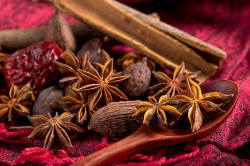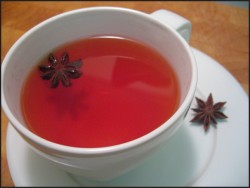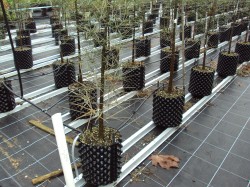
Many growers would give little thought to the roots of their cannabis plants beyond ensuring that they are healthy, supplied with water, nutrients, oxygen and drainage, before discarding them at harvest time. But the roots have been used in folk medicine for millennia and contain compounds of medicinal value.
The oft-cited Chinese herbal encyclopaedia from around 2700 BC mentions cannabis root, dried and ground to form the basis of a paste used to reduce pain caused by broken bones or surgery. It was also crushed to extract the fresh juice, or boiled to make a decoction and used as a diuretic; an anti-haemorrhagic to stop post-partum bleeding in childbirth (and other forms of bleeding); ease difficult childbirth and reduce pain and swelling from bruises and scrapes.
The Roman historian Pliny the Elder wrote in his Naturalis Historia (77-79 AD) that cannabis root could be boiled in water to make a preparation that relieved joint cramps, gout and acute pain and that the raw root could be applied directly to burns to reduce pain and blistering. The Roman physician Dioscorides also attested to boiled cannabis root poultices to treat inflammation, gout and ‘twisted sinews’.
Between the 11th and 12th centuries there is documentation that the juice of the cannabis leaves was used to cure abscesses and an 'oily wax' made from hemp seed oil was applied to tumours. The oil was used as a painkiller for earaches, for soothing neurological pain and the boiled leaves were used to wash the body to kill lice, nits and other parasites. There is a historical record of cannabis’s topical uses in Tibetan medicine. In Thailand, Cannabis sativa is combined with various other herbs and spices including Mugwort, Black pepper, Ginger and the Ceylon Cinnamon Tree to make a tincture used to treat haemorrhoids, laryngeal polyps and ulcers in the intestinal and genital areas. In Malaysia, Hydnocarpus anthelmintica and Cannabis sativa were used topically for the treatment of leprosy (Chaulmoogra oil). In Cambodia, Cannabis sativa and various other herbs and spices were macerated and used to treat stiffness following childbirth.

In Western herbal tradition, rheumatism oil (1856) was made from Cannabis sativa, poppy and henbane to relieve pain. In Arabic medicine, Cannabis sativa has a long and vast history of topical use. The English physician, William Salmon wrote in the early 18th century that cannabis root could be mixed with barley flower and applied as a poultice to treat sciatica and pelvic joint pain. From the late 18th century up to the turn of the 20th century, American physicians would recommend decoctions of cannabis root to treat inflammation, incontinence and venereal disease. There was also mention of cannabis oil being used for treating vitiligo and leprosy. The leaves of cannabis were also used as a hair rinse to stimulate hair growth.
Modern-day and Anecdotal Use of Cannabis Roots
Many modern-day growers, as well as dispensaries and patients in the US, utilise preparations made from cannabis root to provide subjective relief from a range of ailments. Some home-brew cannabis root ‘tea’, usually by slowly simmering the dried, powdered root (often with cinnamon bark, anise, or other aromatics) in a slow cooker (crock pot) for twelve hours or more before straining and drinking. It can also be reduced down to an extract for tinctures or liniments. Others will simmer the root in oil and water before separating out the residual oil and using as the basis for topical medications. Some even use the root in its dry, powdered form to make dry poultices that can help soothe and heal burns, cuts and skin complaints such as dermatitis. There is even a report of dried, powdered root being used to ‘draw out’ the venom from a scorpion sting; this may have some validity, as fresh cannabis juice was apparently used for this purpose in ancient China. When used topically cannabis does not have the psychoactive effects that are felt when smoked or ingested.
Many modern-day growers, as well as dispensaries and patients in the US, utilise preparations made from cannabis root to provide subjective relief from a range of ailments. Some home-brew cannabis root ‘tea’, usually by slowly simmering the dried, powdered root (often with cinnamon bark, anise, or other aromatics) in a slow cooker (crock pot) for twelve hours or more before straining and drinking. It can also be reduced down to an extract for tinctures or liniments. Others will simmer the root in oil and water before separating out the residual oil and using as the basis for topical medications. Some even use the root in its dry, powdered form to make dry poultices that can help soothe and heal burns, cuts and skin complaints such as dermatitis. There is even a report of dried, powdered root being used to ‘draw out’ the venom from a scorpion sting; this may have some validity, as fresh cannabis juice was apparently used for this purpose in ancient China. When used topically cannabis does not have the psychoactive effects that are felt when smoked or ingested.

There is new and promising research into its topical applications especially in the areas of skin cancer,
inflammation and for its antimicrobial and anti-fungal properties.
Topical use is mainly through liniments, salves and cannabis oil/s. According to Americans for Safe Access, 'Guide to using medical cannabis'; Cannabis Topicals (applied to the skin) - cannabinoids combined with a penetrating topical cream can enter the skin and body tissues and allow for direct application to affected areas (e.g. allergic skin reactions, post-herpes neuralgia, muscle strain, inflammation, swelling). Topicals may produce anti-inflammatory and analgesic or pain relief effects. Research has to date been limited to studies on allergic and post-herpes skin reactions and pain relief. Anecdotal reports on topical treatment efficacy include:
- Dermatitis (including atopic) and psoriasis
- Balm for lips, fever blisters, herpes
- Superficial wounds, cuts, acne pimples, boils, corns, certain nail fungus
- Rheumatism and arthritic pains
- Torticollis (Wry Neck), back pains, muscular pains and cramps, sprains and other contusions
- Phlebitis, venous ulcerations
- Haemorrhoids
- Menstruation pains
- Cold and sore throat, bronchitis
- Asthmatic problems
- Chronic inflammation of larynx (compress)
- Migraine, head pains, tension headaches
- Pharmaceutical Cannabis or Cannabinoids
Cannabinoids in the Roots
 A Canadian study found that cannabis flowers contained CBDA (the acidic precursor to CBD) at approximately 2.4% concentration, while the leaves, stems and roots contained 0.5%, 0.04% and 0.004% respectively. The various parts also contained the precursor to CBDA, a substance known as hexanoyl-CoA, in concentrations of 15.5%, 4.0%, 2.2% and 1.5% respectively.
A Canadian study found that cannabis flowers contained CBDA (the acidic precursor to CBD) at approximately 2.4% concentration, while the leaves, stems and roots contained 0.5%, 0.04% and 0.004% respectively. The various parts also contained the precursor to CBDA, a substance known as hexanoyl-CoA, in concentrations of 15.5%, 4.0%, 2.2% and 1.5% respectively.
 A Canadian study found that cannabis flowers contained CBDA (the acidic precursor to CBD) at approximately 2.4% concentration, while the leaves, stems and roots contained 0.5%, 0.04% and 0.004% respectively. The various parts also contained the precursor to CBDA, a substance known as hexanoyl-CoA, in concentrations of 15.5%, 4.0%, 2.2% and 1.5% respectively.
A Canadian study found that cannabis flowers contained CBDA (the acidic precursor to CBD) at approximately 2.4% concentration, while the leaves, stems and roots contained 0.5%, 0.04% and 0.004% respectively. The various parts also contained the precursor to CBDA, a substance known as hexanoyl-CoA, in concentrations of 15.5%, 4.0%, 2.2% and 1.5% respectively.
Cannabis roots are primarily composed of sugars and lipids with low levels of terpenes, alkaloids and various other compounds. In 1971 it was determined that ethanol extract of cannabis roots contained the terpenes friedelin, pentacyclic triterpene ketones, and epifriedelanol. Friedelin is thought to have hepatoprotective (liver-protecting) and antioxidant effects; epifriedelanol has been demonstrated to have anti-tumour effects, and several pentacyclic triterpene ketones are thought to cause apoptosis (programmed cell death) in cancer cells, as well as reducing inflammation, pain and bacterial infection and possessing diuretic and immuno-modulatory properties.
As well as terpenoids, several alkaloids that may be of medicinal value have been identified in cannabis roots. The alkaloids piperidine and pyrrolidine have both been found in the roots, as well as in the stems, seeds, pollen and leaves; these alkaloids can be highly toxic in high doses, but in smaller doses have been found to have various medicinal benefits. Piperidine is used as a chemical ‘building block’ for various pharmaceuticals, particularly those involved in psychiatric medicine such as paroxetine and haloperidol; pyrrolidine is also used as a building block for a class of stimulant drugs known as racetams.
The roots of cannabis have also been noted to contain choline and atropine in small quantities. Choline is an essential dietary nutrient that is the precursor to the predominant neurotransmitter acetylcholine and is thought to be crucial to the maintenance of healthy cell membranes. It is thought that post-menopausal women are extremely likely to be deficient in choline, meaning that hemp-root tea consumed orally could provide important benefits. Atropine is well-known as a means to dilate the pupil and relax the eye muscles; it also has bronchodilatory properties, and is used to increase heart rate during medical resuscitation.
If cultivating with a view to utilising the roots, hydroponic and aeroponic techniques are preferable as they allow for a finer degree of precision when administering nutrients, enable the grower to regularly inspect for progress and signs of ill-health, and ensure that the roots will be clean and free from soil. Plant breeders have developed specialised systems to maximise root health and growth; the best-known technique involves integrated air-pruning of roots to encourage dense growth within a specified volume.
Air-pruning of roots refers to the natural die-off of roots when exposed to low humidity and air; there are various pots and trays with perforated sides available, which enable it to occur effectively. As the roots die off, the plant continually regenerates new roots, and the root ball itself becomes thick and dense. It is preferable to air-prune rather than allow roots to hit the sides of pots and then continue to grow around the container, as this leads to twisted, strangulated roots that exhibit reduced nutrient uptake. As well as ensuring the good health of the roots themselves, air-pruning also improves the plant’s overall health and eventual yield.
 Anyone lucky enough to be able to cultivate cannabis can also take advantage of the potential benefits of cannabis roots. With a little effort and perseverance (and some trial and error) it's even possible to select a variety of strains to be used alone or in combination, to make balms with a range of potency and uses. Typically, cannabis roots are dried prior to processing. The dried root mass is broken into small chunks and ground into powder (pestle/mortar or blender). Once the dried root is roughly powdered it is added to a slow cooker (crock pot) along with oil and water and gently heated for up to 12 hours, allowing the volatile compounds (including terpenoids and cannabinoids) to dissolve in the oil. The water prevents the mixture from drying out or ‘frying’ the roots (check hourly and add water as required). Once heating is complete, the liquid is strained and the residual root pulp frozen for processing a second time. The liquid is then frozen to separate the oils from the water; volatile oils will rise to the surface and can be scraped off as a semi-solid. At room temperature the oil will liquefy and have a smooth, translucent appearance. Once all the oil has been separated from the ice, it can be reheated and beeswax added to achieve a more spreadable consistency at room temperature. Trial and error is the best way to establish the desired consistency. Aromatic essential oils can be added to the mixture to improve the fragrance or enhance the medicinal properties; bergamot for cold sores and psoriasis; chamomile for eczema, dermatitis and inflammation; neroli for scars and stretch marks; or black pepper for muscle aches, cramps and arthritis.
Anyone lucky enough to be able to cultivate cannabis can also take advantage of the potential benefits of cannabis roots. With a little effort and perseverance (and some trial and error) it's even possible to select a variety of strains to be used alone or in combination, to make balms with a range of potency and uses. Typically, cannabis roots are dried prior to processing. The dried root mass is broken into small chunks and ground into powder (pestle/mortar or blender). Once the dried root is roughly powdered it is added to a slow cooker (crock pot) along with oil and water and gently heated for up to 12 hours, allowing the volatile compounds (including terpenoids and cannabinoids) to dissolve in the oil. The water prevents the mixture from drying out or ‘frying’ the roots (check hourly and add water as required). Once heating is complete, the liquid is strained and the residual root pulp frozen for processing a second time. The liquid is then frozen to separate the oils from the water; volatile oils will rise to the surface and can be scraped off as a semi-solid. At room temperature the oil will liquefy and have a smooth, translucent appearance. Once all the oil has been separated from the ice, it can be reheated and beeswax added to achieve a more spreadable consistency at room temperature. Trial and error is the best way to establish the desired consistency. Aromatic essential oils can be added to the mixture to improve the fragrance or enhance the medicinal properties; bergamot for cold sores and psoriasis; chamomile for eczema, dermatitis and inflammation; neroli for scars and stretch marks; or black pepper for muscle aches, cramps and arthritis.
Knowledge of all of the properties of cannabis root is still in its infancy, and as the industry continues to develop, it is likely that even more applications will be developed.
adapted from Getting Down To The Roots Of Cannabis
and Topical Uses for Cannabis sativa L. with additional information from Americans for Safe Access and Granny Storm Crow's List 2015




No comments:
Post a Comment